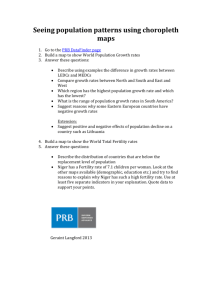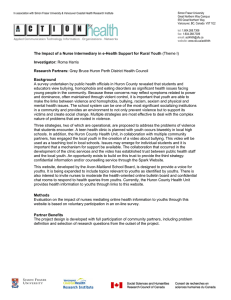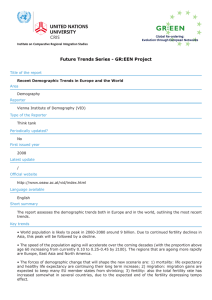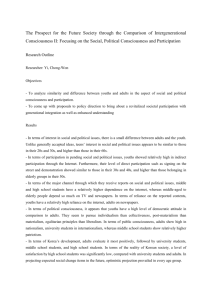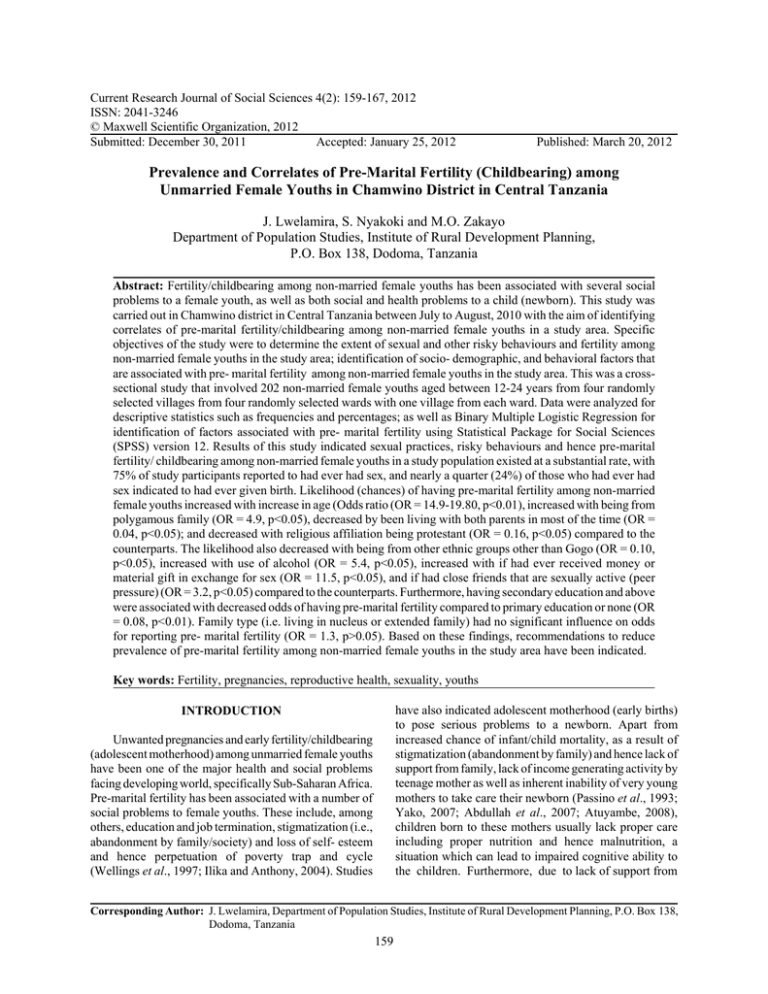
Current Research Journal of Social Sciences 4(2): 159-167, 2012
ISSN: 2041-3246
© Maxwell Scientific Organization, 2012
Submitted: December 30, 2011
Accepted: January 25, 2012
Published: March 20, 2012
Prevalence and Correlates of Pre-Marital Fertility (Childbearing) among
Unmarried Female Youths in Chamwino District in Central Tanzania
J. Lwelamira, S. Nyakoki and M.O. Zakayo
Department of Population Studies, Institute of Rural Development Planning,
P.O. Box 138, Dodoma, Tanzania
Abstract: Fertility/childbearing among non-married female youths has been associated with several social
problems to a female youth, as well as both social and health problems to a child (newborn). This study was
carried out in Chamwino district in Central Tanzania between July to August, 2010 with the aim of identifying
correlates of pre-marital fertility/childbearing among non-married female youths in a study area. Specific
objectives of the study were to determine the extent of sexual and other risky behaviours and fertility among
non-married female youths in the study area; identification of socio- demographic, and behavioral factors that
are associated with pre- marital fertility among non-married female youths in the study area. This was a crosssectional study that involved 202 non-married female youths aged between 12-24 years from four randomly
selected villages from four randomly selected wards with one village from each ward. Data were analyzed for
descriptive statistics such as frequencies and percentages; as well as Binary Multiple Logistic Regression for
identification of factors associated with pre- marital fertility using Statistical Package for Social Sciences
(SPSS) version 12. Results of this study indicated sexual practices, risky behaviours and hence pre-marital
fertility/ childbearing among non-married female youths in a study population existed at a substantial rate, with
75% of study participants reported to had ever had sex, and nearly a quarter (24%) of those who had ever had
sex indicated to had ever given birth. Likelihood (chances) of having pre-marital fertility among non-married
female youths increased with increase in age (Odds ratio (OR = 14.9-19.80, p<0.01), increased with being from
polygamous family (OR = 4.9, p<0.05), decreased by been living with both parents in most of the time (OR =
0.04, p<0.05); and decreased with religious affiliation being protestant (OR = 0.16, p<0.05) compared to the
counterparts. The likelihood also decreased with being from other ethnic groups other than Gogo (OR = 0.10,
p<0.05), increased with use of alcohol (OR = 5.4, p<0.05), increased with if had ever received money or
material gift in exchange for sex (OR = 11.5, p<0.05), and if had close friends that are sexually active (peer
pressure) (OR = 3.2, p<0.05) compared to the counterparts. Furthermore, having secondary education and above
were associated with decreased odds of having pre-marital fertility compared to primary education or none (OR
= 0.08, p<0.01). Family type (i.e. living in nucleus or extended family) had no significant influence on odds
for reporting pre- marital fertility (OR = 1.3, p>0.05). Based on these findings, recommendations to reduce
prevalence of pre-marital fertility among non-married female youths in the study area have been indicated.
Key words: Fertility, pregnancies, reproductive health, sexuality, youths
have also indicated adolescent motherhood (early births)
to pose serious problems to a newborn. Apart from
increased chance of infant/child mortality, as a result of
stigmatization (abandonment by family) and hence lack of
support from family, lack of income generating activity by
teenage mother as well as inherent inability of very young
mothers to take care their newborn (Passino et al., 1993;
Yako, 2007; Abdullah et al., 2007; Atuyambe, 2008),
children born to these mothers usually lack proper care
including proper nutrition and hence malnutrition, a
situation which can lead to impaired cognitive ability to
the children. Furthermore, due to lack of support from
INTRODUCTION
Unwanted pregnancies and early fertility/childbearing
(adolescent motherhood) among unmarried female youths
have been one of the major health and social problems
facing developing world, specifically Sub-Saharan Africa.
Pre-marital fertility has been associated with a number of
social problems to female youths. These include, among
others, education and job termination, stigmatization (i.e.,
abandonment by family/society) and loss of self- esteem
and hence perpetuation of poverty trap and cycle
(Wellings et al., 1997; Ilika and Anthony, 2004). Studies
Corresponding Author: J. Lwelamira, Department of Population Studies, Institute of Rural Development Planning, P.O. Box 138,
Dodoma, Tanzania
159
Curr. Res. J. Soc. Sci., 4(2): 159-167, 2012
family and lack of income by adolescent mother, children
of these mothers can also miss schools and hence
increased number of street children in urban areas
(Musoke, 1996; Namwata et al., 2011). In order to device
effective intervention to curb the above problems,
knowledge on the factors responsible for pre-marital
fertility/ childbearing among non-married female youths
is important. Scant information exists on the above
aspects in most parts of Tanzania, particularly in rural
areas. Therefore, based on this background, this study
aimed at identifying correlates for pre-marital fertility
among non-married female youths in central area of
Tanzania, by taking a case of Chamwino District.
Specifically, the study intended at determining the extent
of sexual and other risky behaviours and fertility among
non-married female youths in the area; and identification
of socio-demographic, and behavioral factors that are
associated with pre-marital fertility among non-married
female youths in the study area.
n
( Z / 2 ) 2 P(1 P)
2
where by n = sample size; P=percentage of non-married
female youths in the area that had ever given birth ;
8=maximum error; since P was not known for the study
population, its value was assumed to be 50% as it ensures
maximum sample size (Nwankwo and Nwoke, 2009). By
assuming confidence interval of 95% for the estimated
population proportion, maximum error of 10% and design
effect of 2 (Kisinza et al., 2008) that is n×2 and non
response rate of 5%, a final sample was calculated to be
202 individuals.
Data for this study was collected using a pre-tested
semi-structured questionnaire. Pre-testing of questionnaire
was done in villages not involved in this study. During
data collection, informed verbal consent was directly
asked from the respondent before interview for
respondents aged 18 and above. For respondents aged
below 18 years, informed verbal consent was asked from
their parents/ guardian before interview.
METHODOLOGY
Study area: This study was carried in four randomly
selected villages from four randomly selected wards out
of 28 wards of Chamwino District in Central Tanzania,
with one village from each ward. The District is among
six district of Dodoma region in Central Tanzania. The
district is located between latitude 4 and 8° South and
longitude 36 and 37° East. The district covers an area of
7870 km2 with a population of 260, 841 people (URT,
2008). The area is semi-arid which receives annual
rainfall of between 500 to 800 mm. The dominant ethnic
group is Gogo involved in both crop and livestock
production.
Conceptual framework: In this study it was
conceptualized that demographic, social environment and
behavioral variables indirectly influence pre-marital
fertility through its influence on sexual behaviours of nonmarried female youths, and these sexual behaviours in
turn directly influence pre-marital fertility (i.e., proximate
determinants) (Onuoha, 1992; Palamuleni, 1997; Fitaw
et al., 2003). These demographic variables included age,
education level, and religion affiliation. Social
environment variables included living arrangement
(whom mostly been living with), type of marriage by
parents, family type, ethnicity (cultural environment) and
peer pressure. Behavioral variables included alcohol
consumption and if ever received money or material gift
in exchange for sex. Sexual behaviours (risky sexual
behaviours) which were thought to influence pre-marital
fertility directly following the influence of demographic,
social environment and behavioral variables on them
included engagement in sexual activity (sexual
intercourse), non-use of contraceptives such as condoms,
and having multiple sexual partners. Relationship between
these variables is summarized in the Fig. 1;
Study design: This study was carried out in the study
area between July to August, 2010. The study involved a
cross-sectional survey in four randomly selected villages
from four randomly selected wards of Chamwino district
with one village from each ward. The villages include
Nzari, Mahamha, Mvumi makulu and Muungano. The
study involved 202 non-married (i.e., never married)
female youths aged between 12 to 24 years from 202
randomly chosen households (i.e., one individual per
household). Nearly equal numbers of individuals (i.e.,
around 50 non-married female youths per village) were
selected from each village. During sampling, incase a
household was found to have no non-married female
youth, a household was replaced by another nearby
household chosen at random. Furthermore, if a household
was found to have more than one non-married female
youth, only one non-married female youth chosen at
random was considered for interview. Sample size was
estimated using the following formula (Amin, 2002).
Statistical analysis: Data were analyzed for Descriptive
Statistics such as Frequencies and Percentages using
Statistical Package for Social Sciences (SPSS) version 12.
Furthermore, SPSS program was also used to run a Binary
Multiple Logistic Regression Analysis to identify factors
that are significantly associated with pre-marital fertility
among non-married female youths in a study population
using the following model (Maddala, 1983; Hosmer and
Lemeshow, 2000; Agresti, 2002).
160
Curr. Res. J. Soc. Sci., 4(2): 159-167, 2012
Independent variables
Dependent variables
Intermediate variables
Demographic variables
Age
Education level
Religion
Social environment
living arrangement
Type of marriage by parents
Family type
Cultural environment
(Ethnicity/tribe)
Peer pressure
Behavioral variables
Risky sexual behaviors
Engagement in sexual activity
(sexual intercourse)
Non use of contraceptives
(i.e condom)
Pre-marital fertility
among non-married
females youths
Having multiple sexual partners
If consumer/take alcohol
If ever received money/material
gift in exchange for sex
(as a result of poverty )
Fig. 1: Conceptual framework (Fitaw et al., 2003)
used as a reference category. Based on literature, in this
study it was hypothesized that likelihood of pre-marital
fertility among non-married female youths increase with
increase in ages, having lower education level, type of
marriage by parents being polygamous, living with single
parents or relatives or friends, living in extended family,
being from Gogo ethnic group, having close friends that
are sexually active, if ever received money or material gift
in exchange for sex (as a result of poverty), and if use
alcohol; and decrease by a religion affiliation being
protestant.
n
p
1n
i X i
1 p
i 1
whereby p is a probability of had ever give birth (ever
had pre-marital fertility); " and $ are estimated regression
coefficients, and Xi are various explanatory variables.
Odds ratio (OR) for determining the effect of various
categories of explanatory variables on likelihood of premarital fertility by a non-married (i.e., never married)
female youth were estimated by computing Exp ($) for
each variable (Hosmer and Lemeshow, 2000).
Variables used in this analysis were “If had ever
given birth” (binary)(1 = Yes, 0 = No), a dependent
variable; Independent (explanatory variables) included;
Age of respondent in years with three categories (1 = <15,
2 = 15-18, 3 = >18); Education level of respondent with
two categories (1 = Primary or none, 2 = Secondary and
above); Religion affiliation with three categories (1 =
Catholic, 2 = Protestant, 3 = Moslem); Ethnicity (tribe)
with two categories (1 = Gogo, 2 = Others); Type of
marriage by parents with two categories (1 = Monogamy,
2 = Polygamy); Whom mostly been living with/living
arrangement with three categories (1 = Single parent, 2 =
Both parents, 3 = Others); Family type with two
categories (1 = Nucleus, 2 = Extended); If ever received
money or material gift in exchange for sex with two
categories (1 = No, 2 = Yes); If close friends are sexually
active with two categories (1 = No, 2 = Yes); If use
alcohol with two categories (1 = No, 2 = Yes). During
analysis, first category for each explanatory variable was
RESULTS AND DISCUSSION
Socio-demographic characteristics of respondents:
Socio-demographic variables are among important factors
influencing sexual practices and consequently fertility
among youths (Fitaw et al., 2003; Maria, 2007; Okonta,
2007; Seifu et al., 2006). Results from Table 1 indicate
nearly half (48%) of total respondents aged between 1518 years, with around 35% aged more than 18 years,
reflecting overwhelming majority of respondents were in
sexually active age (Okonta, 2007; Bankole et al., 2007)
and hence more likely to engage in sexual activity leading
to pregnancies and fertility among them. Similar to other
studies done on youths in other parts of Tanzania (Lema
et al., 2008; Zakayo and Lwelamira, 2011), more than
95% of respondents had at least primary education with
more than a quarter (28%) having secondary education, a
situation which reflects good literacy level by a study
population and hence more likely to poses good ability to
161
Curr. Res. J. Soc. Sci., 4(2): 159-167, 2012
Table 1: Socio-demographic characteristics of respondents (n = 202)
Variable
Frequency
Percent
Age (years)
<15
35
17.3
15-18
97
48.0
>18
70
34.7
Highest level of school attended
None
5
2.5
Primary
141
69.8
Secondary or higher
56
27.7
Religious affiliation
Catholic
52
25.7
Protestant
134
66.3
Moslem
16
7.9
Ethnicity (tribe)
Gogo
153
75.7
Others
49
24.3
Whom mostly been living with
(living arrangement)
Single parent
55
27.2
Both parents
123
60.9
Others (guardian, friend)
24
11.9
Type of marriage by parents
Monogamy
150
74.3
Polygamy
37
18.3
Not applicable (N/A)
15
7.4
Family type at home
Nucleus family
138
68.3
Extended family
64
31.7
Table 2: Sexual and other risky behaviours
Variable
Frequency
If ever had sex (n = 202)
Yes
152
No
50
If ever experienced sex, number of
lifetime sexual partners (n = 152)
One
115
Two
21
Three and more
16
If ever experienced sex, consistency
of condom used (n = 152)
Always use
62
Sometimes/occasionally use
39
Never used
51
If ever received money/ material gift
in exchange for sex (n = 152)
Yes
33
No
119
If use alcohol (n = 202)
Yes
50
No
152
If close friends are sexually active
(engage in sexual activity frequently) (n = 202)
Yes
59
No
143
Percent
75.2
24.8
75.7
13.8
10.5
40.8
25.6
33.6
21.7
78.3
24.8
75.2
29.3
70.8
Ezeh, 2007; Zakayo and Lwelamira, 2011), as well as
risks of early pregnancies and adolescents motherhood.
Results from Table 1 indicate considerable proportion of
respondents were living in environment in which parental
control could sometimes be minimal and hence increased
chances of engaging in sexual activities, leading to
youths/adolescents pregnancies and motherhood. About
39% of study participants, that is nearly four in very ten
unmarried female youths were living with either a single
parent, or other relatives or friends; 18%, that is nearly
one in every five unmarried female youths were living in
polygamous family, and nearly one-third (32%) were
living in extended families.
process information such as HIV/AIDS prevention
packages and other sexual and reproductive health
promotion materials (Mgabo et al., 2010). Result from
Table 1 also reveal that most of the respondents were
Protestants accounting for 66% of total respondents,
followed by Catholic which account for 26%; very few
(less than 10%) of the respondents were Moslem.
Variations in religion affiliation among study participants
observed in this study may results into noticeable
differences in religious ideology/beliefs among them
(Odimegwu, 2005; Madise et al., 2007), which could
consequently influencing their perception on sexual
activity and overall sexual and reproductive health issues,
including pre-marital pregnancies and fertility. Sociocultural differences resulting from differences in
ethnicity/tribe between individuals could also be
important variables influencing perceptions, beliefs,
attitudes and practices towards issues related to sexual
and reproductive health including adolescents’
pregnancies and motherhood by an individual (Sunmola
et al., 2002; Okonta, 2007; Ikamari, 2008; Garenne and
Zwang, 2008). Although majority of study participants
were Gogo (75%), a dominant ethnic group in the
area, however, there was a substantial proportion of
respondents (a quarter) that were coming from other tribes
(i.e., Hehe, Kagulu, Nyamwezi), indicating existence of
ethnic diversity in a study population and hence there
could be differences in socio-cultural beliefs and practices
related sexual and reproductive health issues. Parental
control has been indicated to be one of the important
factors that influencing youths’ sexual activity (Abu and
Akerele, 2006; Kumi-Kyereme et al., 2007; Kabiru and
Sexual and other risky behaviours among study
participants: Results from Table 2 indicate three-quarter
(75%) of total respondents had ever experienced sex,
indicating majority of unmarried female youths in a study
population were sexually active. Furthermore, prevalence
of risky sexual behaviours and other risky behaviours
among unmarried female youths in a study population
were also at a substantial rate, a situation which
predisposes them to the risk of early pregnancies, early
motherhood and sexually transmitted diseases (STDs). Of
the study participants who had ever experienced sex,
nearly a quarter of them (24.3%) had multiple sexual
partners, with only 41%, that is around 4 in every 10
unmarried female youths that had ever experienced sex
used condom consistently, and around one- third of them
(34%) never used it in all sexual encounters (Table 2).
Existence of multiple sexual partners and low or non-use
of condom by a significant proportion of youths were also
reported in previous studies done in other parts of
162
Curr. Res. J. Soc. Sci., 4(2): 159-167, 2012
Table 3: Prevalence of pre-marital fertility/childbearing among female
youths in a study population
Variable
Frequency
Percent
If ever given birth (N = 202)
Yes
49
24.3
No
153
75.7
Age at first birth (N = 49)
#15
6
12.3
16-18
20
40.8
>18
23
46.9
Number of births ever had (N = 49)
1
41
83.7
2
6
12.3
3 and above
2
4.0
Tanzania as well as other parts of Africa (Seifu et al.,
2006; Kibombo et al., 2007; Lema et al., 2008; Zakayo
and Lwelamira, 2011). Furthermore, 22%, that is around
two in very ten unmarried female youths that had ever
experienced sex, had ever had received money or material
gift in exchange for sex, a situation which reflect
existence of transactional sex among unmarried female
youths in a study population. Similarly, around a quarter
(24.8%) of all study participants indicated to consume
alcohol, while 29% (nearly one-third) had close friends
who are sexually active (Table 2). Studies have indicated
alcohol intake increases likelihood of an adolescent/youth
to engage in risky sexual behaviours such as unprotected
sex and hence increased chances of early pregnancies and
motherhood and increased risk of acquiring STDs
(Setshed and de la Monte, 2011; Tegang et al., 2011).
Furthermore, as a result of peer pressure, adolescent/youth
with close friends that are sexually, she/he is also more
likely to engage sexual activity (Seifu et al., 2006), and
hence increased likelihood of risks associated with early
engagement in sexual activity such as adolescent
motherhood and associated problems.
Table 4: Results for binary multiple logistic regression analysis for
reporting birth (dependent variable) against various sociodemographic and some behavioral variables
Standard
Wald- Odds ratio
$ error (S.E) statistic (or)Exp ($) Sign.
Predictor
Age (years)
<15 (Ref.)
15-18
2.99
1.16
6.62
19.80
**
>18
2.70
0.87
9.62
14.94
**
Education level attained
None or primary (Ref.)
Secondary and above -2.50 0.98
6.57
0.08
**
Religion affiliation
Catholic (Ref.)
Protestant
-1.82 1.37
1.76
0.16
*
Moslem
0.30
1.26
0.06
1.35
NS
Ethnicity (tribe)
Gogo (Ref.)
Others
-2.26 1.17
3.76
0.10
*
Type of marriage by parents
Monogamy (Ref.)
Polygamy
1.60
0.75
4.53
4.92
*
Whom mostly been living with (living arrangement)
Single parent (Ref.)
Both parents
-3.34 1.49
5.06
0.04
*
Others (guardian,
-0.75 1.38
0.30
0.47
NS
friend)
Family type
Nucleus (Ref.)
Extended
0.26
1.4
0.03
1.30
NS
If ever received money/ material gift in exchange for sex
No (Ref.)
Yes
2.44
1.19
4.23
11.48
*
If close friends are sexually active
No (Ref.)
Yes
1.15
1.09
1.11
3.16
*
If use alcohol
No (Ref.)
Yes
1.68
0.87
3.74
5.38
*
Nagelkerke R square: 0.73; Ref.: Reference category; ns: Nonsignificant (p>0.05); *: Significant at p<0.05; **: Significant at p<0.01
Prevalence of pre-marital fertility/childbearing among
study participants: Consequences of pre-marital fertility
to female youths as well as its effect to the newborn are
well documented (Wellings et al., 1997; Ilika and
Anthony, 2004; Abdullah et al., 2007; Atuyambe, 2008).
Findings from Table 3 indicate a considerable proportion
of respondents (unmarried female youths), which is nearly
a quarter (24.3%), had ever given birth. Furthermore, age
at first birth by half of respondents (53%) that had ever
given birth was 18 years and below, a situation which
indicates existence of adolescent motherhood in a study
population at a substantial rate. This is an undesirable
trend in a study population. It can also be noted from
Table 3 that about 12% of unmarried female youths that
had ever given birth, that is around one in every ten, had
given birth at the age of 15 years and below, implying
very young age at first birth by a noticeable proportion of
respondents, a trend which threatens lives of female
youths in a study population. Evidence from past studies
indicate chances of maternal and infant mortalities
increases with decreasing age of mother, and likelihood
for such events are very high for very young mothers
(Ilika and Anthony, 2004; Atuyambe, 2008). Number
of births ever had by majority of respondents (84%)
was one (1).
married female youths in a study population. This was
done through Binary Multiple Logistic Regression
Analysis. Results are presented in Table 4. Effect of most
of the explanatory variables on pre-marital fertility
considered in this analysis was on expected direction.
Results indicate that increased age was associated
with increased likelihood of pre-marital fertility. Nonmarried female youths aged 15 years and above were 15
to 20 times more likely to have ever given birth compared
Correlates of pre-marital fertility among unmarried
female youths in a study population: This study was
also interested in identifying socio-demographic and
behavioral factors associated with increased chance of
pre-marital fertility (pre-marital childbearing) among non163
Curr. Res. J. Soc. Sci., 4(2): 159-167, 2012
parents by a non-married female youth was associated
with decreased chance of pre-marital fertility compared to
those living with single parents (OR = 0.04, p<0.05).
Living with others (i.e., friends, relatives) had no
significant influence on likelihood of reporting pre-marital
fertility by a non-married female youth relative to those
living with single parents (OR = 0.47, p>0.05).
Surprisingly, family type (i.e., living in nucleus vs
extended family) had no significant influence on
likelihood of reporting pre-marital fertility (OR = 1.30,
p>0.05). Significant effect of type of marriage by parents
and living arrangement on youths’ sexuality including
early pregnancies and motherhood relies on their effects
on youths/ adolescents sexual behaviours through parental
control (Abu and Akerele, 2006; Kumi-Kyereme et al.,
2007; Kabiru and Ezeh, 2007; Zakayo and Lwelamira,
2011). Results on the effects of these variables on
likelihood of pre-marital fertility are on expected
direction. Parental control for youths living with single
parent/ friend/ guardian and a youth living in a
polygamous family is more likely to be low and hence
increased chances of engaging in sexual activity that
could lead to increased chances of early pregnancies and
motherhood. This study was also interested in determining
the effect of behavioral variables by a non-married female
youth as well as behaviours of friends (peer pressure) on
likelihood of having pre-marital fertility. Female youths
that reported to take alcohol were five times more likely
to report had ever had pre- marital fertility compared to
their counterpart (those not taking alcohol) (5.38, p<0.05).
Studies have indicated alcohol consumption stimulates
sexual desires and sometimes it is difficult for an
individual to think of protected sex when he/she is under
influence of alcohol (drunk) (Setshed and de la Monte,
2011; Tegang et al., 2011), consequently increased
chances of risks associated with unprotected sex such as
STDs, early pregnancies and births among youths/
adolescents. Results from Table 4 also indicate that nonmarried female youths with close friends that are sexually
active were three times more likely to report having ever
had pre-marital fertility compared to their counterpart (OR
= 3.16, p<0.05), indicating positive association peer
pressure and engagement in sex, consequently
pregnancies and fertility among unmarried female youths
in a study population. This finding concurs with results of
most studies conducted in other parts of Africa including
other parts of Tanzania (Seifu et al., 2006; Zakayo and
Lwelamira, 2011). Seifu et al. (2006) argued that youths
with sexually active friends are usually forced to engage
in sexual activity to get acceptance of their friends.
High incidences of poverty in Sub Saharan Africa
had encouraged transactional sex among female youths/
adolescents in the area (Moore et al., 2007; Atuyambe,
2008). Evidences from past studies have indicated it is
very difficult for a female youth to negotiate safe sex (i.e.,
to those aged below 15 years (OR = 14.94-19.80, p<0.01).
This trend could be attributed to increased sexual activity
with increasing age among youths as observed in previous
studies (Seifu et al., 2006; Maria, 2007; Seme and Wirtu,
2008). Results from Table 4 also indicate that having at
least secondary education was associated with decreased
odds of pre-marital fertility among unmarried female
youths relative to those with primary education or none
(OR = 0.08, p<0.01). In line with results of this study,
researches conducted in other parts of Sub-Saharan Africa
have indicated higher formal education to have a
protective effect against risky sexual behaviours and the
associated risks such as STDs, unwanted/unintended
pregnancies and births (Maria, 2007; Guiella and Madise,
2007; Utulu and Lawoyin, 2007; Siziya et al., 2008;
Atuyambe, 2008). Some of these authors argued that
formal education brings about better informed choices and
strongly affect the health reasoning ability. It can also be
seen from Table 4 that being a Protestant by a nonmarried female youth was significantly associated with
reduced chance of pre- marital fertility compared of being
a Catholic (OR = 0.16, p<0.05). Being a Moslem had no
significant effect on pre-marital fertility relative to
Catholic (OR = 1.35, p>0.05). Reduced chances of premarital fertility by unmarried female youths with
Protestant religion affiliation could be attributed to the
preaching by the religion that strictly prohibits sex before
religiously approved marriage as observed in a study done
by Odimegwu (2005) in Nigeria. Ethnic variation and
hence cultural differences has been pointed out by a
number of researchers to be one of important factors that
influence perception, attitude and practices towards issues
related to sexuality including pregnancies and fertility
(Sunmola et al., 2002; Ikamari, 2008; Garenne and
Zwang, 2008). In agreement with results of these previous
studies, results from Table 4 indicate ethinicity/ tribe to be
a significant factor influencing pre- marital fertility among
non-married female youths in a study population. Being
from other tribe other than Gogo by a non-married female
youth was associated with reduced likelihood of reporting
had ever had given birth (OR = 0.10, p<0.05). In
agreement to findings of this study, a work by Zakayo and
Lwelamira (2011) in other parts of Central Zone of
Tanzania (i.e. Bahi District) indicated Gogo culture to be
less restrictive to issues related to sex among youths and
hence prevalence of sexual activity among youths from
this tribe at a considerable rate. Other socio-demographic
variables considered in this analysis included type of
marriage by parents, living arrangement by a non-married
female youth, as well as type of family at home. Results
from Table 4 shows unmarried female youths in which
marriage type by parents was polygamous were more
likely to report had ever had given birth compared to
those from parents with monogamous type of marriage
(OR = 4.92, p<0.05). Furthermore, living with both
164
Curr. Res. J. Soc. Sci., 4(2): 159-167, 2012
protected sex) when received money or material gift in
exchange for sex (Amuyunzu-Nyamongo et al., 2005;
Zakayo and Lwelamira, 2011), and hence increased
chances for risks associated with unprotected sex by a
youth including unwanted pregnancies and fertility.
Consistent with these previous studies, results of this
study indicated non-married female youths that had ever
had received money or material gift in exchange for sex
were more likely to report had ever had pre-marital
fertility compared to their counterpart (OR = 11.48,
p<0.05) (Table 4).
credits to run income generating activities by female
youths should be advanced in the area to reduce poverty
and chances of transactional sex among female youths.
CONCLUSION
REFERENCES
Sexual practices, and hence pre-marital fertility/ child
bearing among non-married female youths in a study
population existed at a considerable rate, with three
quarter of study participants reported to had ever had sex,
and nearly a quarter of them (those had ever had sex)
indicated to had ever given birth. Likelihood (odds) of
having pre-marital fertility/childbearing among nonmarried female youths increased with increase in age,
increased with being from polygamous family, decreased
by been living with both parents in most of the time, and
decreased with religious affiliation being protestant
compared to the counterparts. The likelihood also
decreased with being from other ethnic groups other than
Gogo, increased with being alcohol user, increased with
if had ever received money or material gift in exchange
for sex and if had close friends that are sexually active
(peer pressure) compared to the counterparts. Further
more, having secondary education and above were
associated with decreased odds of having pre-marital
fertility compared to primary education or none. Family
type (i.e., living in nucleus or extended family) had no
significant influence on odds for reporting pre-marital
fertility.
Abdullah, K., M.A. Malek, A.S. Faruque, M.A. Salam
and T. Ahmed, 2007. Health and nutritional status of
children of adolescent mothers. Experience from a
diarrhoeal disease hospital in Bangladesh. Acta
Paediatr., 96(3): 396-400.
Abu, P.B. and E.O. Akerele, 2006. Parental influence on
adolescents sexual behaviour in ibadan north local
government area of Oyo state, Nigeria. Int. J. Afr.
Am. Stud., 1: 41-56.
Agresti, A., 2002. Categorical Data Analysis. 2nd Edn.,
John Wiley and Sons Inc., Hoboken, New Jersey,
USA, pp: 710.
Amin, M.E., 2002. Foundations of Statistical Inference
for Social Science Research. Makerere University
Press, Kampala, Uganda, pp: 338.
Amuyunzu-Nyamongo, M.A. Biddlecom E.C. Ouedraogo
and V. Woog, 2005. Qualitative Evidence on
Adolescents’ Views of Sexual and Reproductive
Health in Sub-Saharan Africa. Protecting the Next
Generation: Understanding HIV Risk among Youth
Occasional Report No. 16, 2005. New York:
Guttmacher Institute.
Atuyambe, L.M., 2008. Adolescent motherhood in
Uganda. Dilemmas, Health seeking behaviour and
coping responses responses. PhD. Thesis, Karolinska
Institutet. Stockholm, Sweden, pp: 56.
Bankole, A., A. Biddlecom, G. Guiella, S. Singh and
E. Zulu, 2007. Sexual behaviours, knowledge and
information sources of very young adolescents in
four Sub-Saharan African countries. Afr. J. Reprod.
Health, 11(3): 28-43.
Fitaw, Y., Y. Berhane and A. Worku, 2003. Differential
of fertility in rural butajira. Ethiopian J. Health Dev.,
17(1): 17-25.
Garenne, M. and J. Zwang, 2008. Social context of
premarital fertility in rural South Africa. Afr. J.
Reprod. Health, 12(2): 98-110.
Guiella, G. and N.J. Madise, 2007. HIV/AIDS and
Sexual-Risk Behaviors among Adolescents: Factors
influencing the use of condoms in Burkina Faso. Afr.
J. Reprod. Health, 11(3): 182-196.
ACKNOWLEDGMENT
Authors express their thanks to respondents for their
willingness to participate in the study and their openness
in giving information, as well as good cooperation given
by ward executive officers (WEOs) for wards under
study.
RECOMMENDATIONS
Based on findings of this study, it is recommended
that education on sexual and reproductive health,
including protective sex among non-married female
youths through peer education should be provided in the
study area. For this intervention to be effective, much
emphasis should be on more risky group such as those
living in polygamous; those not living with both parents;
and those coming from Gogo ethnic group. Higher formal
education to female youths should encourage in the area
as it reduce chances of pre-marital sex and fertility.
Furthermore, issues related to youth sexually should be
discussed openly in public gathering including gathering
in prayers houses (i.e., churches). Alcohol abuse among
youths should be strongly discouraged in the area. Small
165
Curr. Res. J. Soc. Sci., 4(2): 159-167, 2012
Namwata, B.M.L., R.M. Mgabo and P. Dimoso, 2011.
Demographic dimensions and their implications on
the incidence of street begging in urban areas of
central Tanzania: The case of Dodoma and Singida
Municipality. Global J. Hum. Soc. Sci., 14(4): 55-61.
Nwankwo, B.O. and E.A. Nwoke, 2009. Risky sexual
behaviour among adolescents in Oweri Municipal:
Predictors of unment family health needs. Afr. J.
Reprod. Health, 13(1): 135-145.
Odimegwu, C., 2005. Influence of religion on adolescent
sexual attitude and behaviour among Nigerian
university students: Affiliation or commitment? Afr.
J. Reprod. Health, 9(2): 125-140.
Okonta, P.I., 2007. Adolescent sexual and reproductive
health in the Niger Delta region of Nigeria-Issues and
challenges. Afr. J. Reprod. Health, 11(1): 113-124.
Onuoha, N., 1992. Contributions of the proximate
determinants to fertility changes in Senegal. Soc. Sci.
Med., 35(100): 1317-1320.
Palamuleni, M., 1997. Proximate determinant of fertility
in Malawi. Tanzania J. Population Stud. Dev., 3(1-2):
65-71.
Passino, A.W., T.L. Whitman, J.G. Borkowski,
C.J. Schellenbach, S.E. Mazwell, D. Keogh and
E. Rellinger, 1993. Personal adjustment and
adolescent parenting. Adolescence, 28(109): 97-122.
Seifu, A., M. Fantahun and A. Worku, 2006.
Reproductive health needs of out of school
adolescents: A cross-sectional comparative study of
rural and urban areas in northwest ethiopia. Ethiopian
J. Health Dev., 20(1): 10-17.
Seme, A. and D. Wirtu, 2008. Pre marital sexual practices
among school adolescents in Nekemte Town East
Ethiopia. Ethiopian J. Health Dev., 22(20): 167-173.
Setshed, M. and S. De La Monte, 2011. Changing trends
and the impact of alcohol on the HIV/AIDS epidemic
in South Africa: Review. J. Soc. Aspects HIV/AIDS,
8(2): 88-95.
Siziya, S., A.S. Muula and E. Rudatsikira, 2008. HIV and
AIDS-related knowledge among women in Iraq.
BMC Res. Notes, 1: 123.
Sunmola, A.M., M. Dipeolu, S. Babalola and A.D. Out,
2002. Reproductive, sexual and contraceptive
behaviour of adolescents in Niger State, Nigeria. Afr.
J. Reprod. Health, 6(3): 82-92.
Tegang, S.P., S. Abdallah, G. Emukule, S.Luchters,
N. Kingola, M. Barasa, S. Mucheke, and P.
Mwarogo, 2011. Concurrent sexual and substanceuse risk behaviours among female sex workers in
Kenya’s Coast Province: Findings from a behavioural
monitoring survey. J. Soc. Aspects HIV/AIDS, 8(2):
9-16.
United Republic of Tanzania (URT), 2008. Chamwino
District Profile, Chamwino District Council,
Dodoma.
Hosmer, D.W. and S. Lemeshow, 2000. Applied Logistic
Regression. 2nd Edn., John Wiley and Sons Inc.,
Hoboken, New Jersey, USA, pp: 375.
Ikamari, L.D.E., 2008. Regional variation in the initiation
of childbearing in Kenya. Afr. Population Stud.,
23(1): 25-40.
Ilika, A. and I. Anthony, 2004. Unintended pregnancy
among Unmarried Adolescents and Young Women in
Anambra State, South East Nigeria. Afr. J.
Reproductive Health, 8(3): 92-102.
Kabiru, C.W. and A. Ezeh, 2007. Factors associated with
sexual abstinence among adolescents in four subSaharan African countries. Afr. J. Reprod. Health,
11(3): 111-132.
Kibombo,R., S. Neema and F.H. Ahmed, 2007.
Perceptions of risk to HIV infection among
adolescents in Uganda: are they related to sexual
behaviour? Afr. J. Reprod. Health, 11(3): 168-181.
Kisinza, W.N., A. Talbert, P. Mutalemwa and H. Mccall,
2008. Community knowledge, attitudes and practices
related to tick-borne relapsing fever in Dodoma rural
District, central Tanzania. Tanzania J. Health Res.,
10(3): 131-136.
Kumi-Kyereme, A., K. Awusabo-Asare, A. Biddlecom
and A. Tanle, 2007. Influence of social
connectedness, communication and monitoring on
adolescent sexual activity in Ghana. Afr. J. Reprod.
Health, 11(3): 133-147.
Lema, L.A., R.S. Katapa and A.S. Musa, 2008.
Knowledge of HIV/AIDS and sexual behaviour
among youths in Kibaha district, Tanzania. Tanzania
J. Health Res., 2: 79-83.
Maddala, G.S., 1983. Limited-dependent variables in
econometrics. Cambridge University Press, pp: 401.
Madise, N., E. Zulu and J. Ciera, 2007. Is poverty a driver
for risky sexual behaviour? evidence from national
surveys of adolescents in four African countries. Afr.
J. Reprod. Health, 11(3): 83-98.
Maria, W., 2007. Sexual behaviour, knowledge and
awareness of related reproductive health issues
among single youth in Ethiopia. Ethiopia J. Health
Dev., 11(1): 14-21.
Mgabo, R.M., J.L.B. Mugane and J. Lwelamira,
2010.Community knowledge perception and
practices towards Bilharzia infection and related
programs in Maisome Island in Sengerema District,
Mwanza, Tanzania. Rural Plan. J., 12:
Moore, A., A. Biddlecom and E. Zulu, 2007. Prevalence
and meanings of exchange of money or gifts for sex
in unmarried adolescent sexual relationships in SubSaharan Africa. Afr. J. Reprod. Health, 11(3): 44-61.
Musoke, I.K., 1996. The structural causes of the problem
of street children in Tanzania: Implications for its
study and efforts towards its alleviation. Tanzania J.
Population Stud., 3(1-2): 83-99.
166
Curr. Res. J. Soc. Sci., 4(2): 159-167, 2012
Utulu, S.N. and T.O, Lawoyin, 2007. Epidemiological
features of HIV infection among pregnant women in
Makurdi, Benue State, Nigeria. J. Biosoc. Sci., 39(3):
397-408.
Wellings, K., J. Wadsworth, A. Johnson, J. Field and
W. Macdowall, 1997. Teenage fertility and life
chances. Rev. Reprod., 4: 184-190.
Yako, E.M., 2007. A comparative study of adolescents’
perceived stress and health outcomes among
adolescent mothers and their infant in Lesotho.
Curationis, 30(1): 15- 25.
Zakayo, A.M. and J. Lwelamira, 2011. Sexual behaviours
among adolescents in community secondary schools
in rural areas of central Tanzania: A case of Bahi
district in dodoma region. Curr. Res. J. Soc. Sci.,
3(4): 374-380.
167

